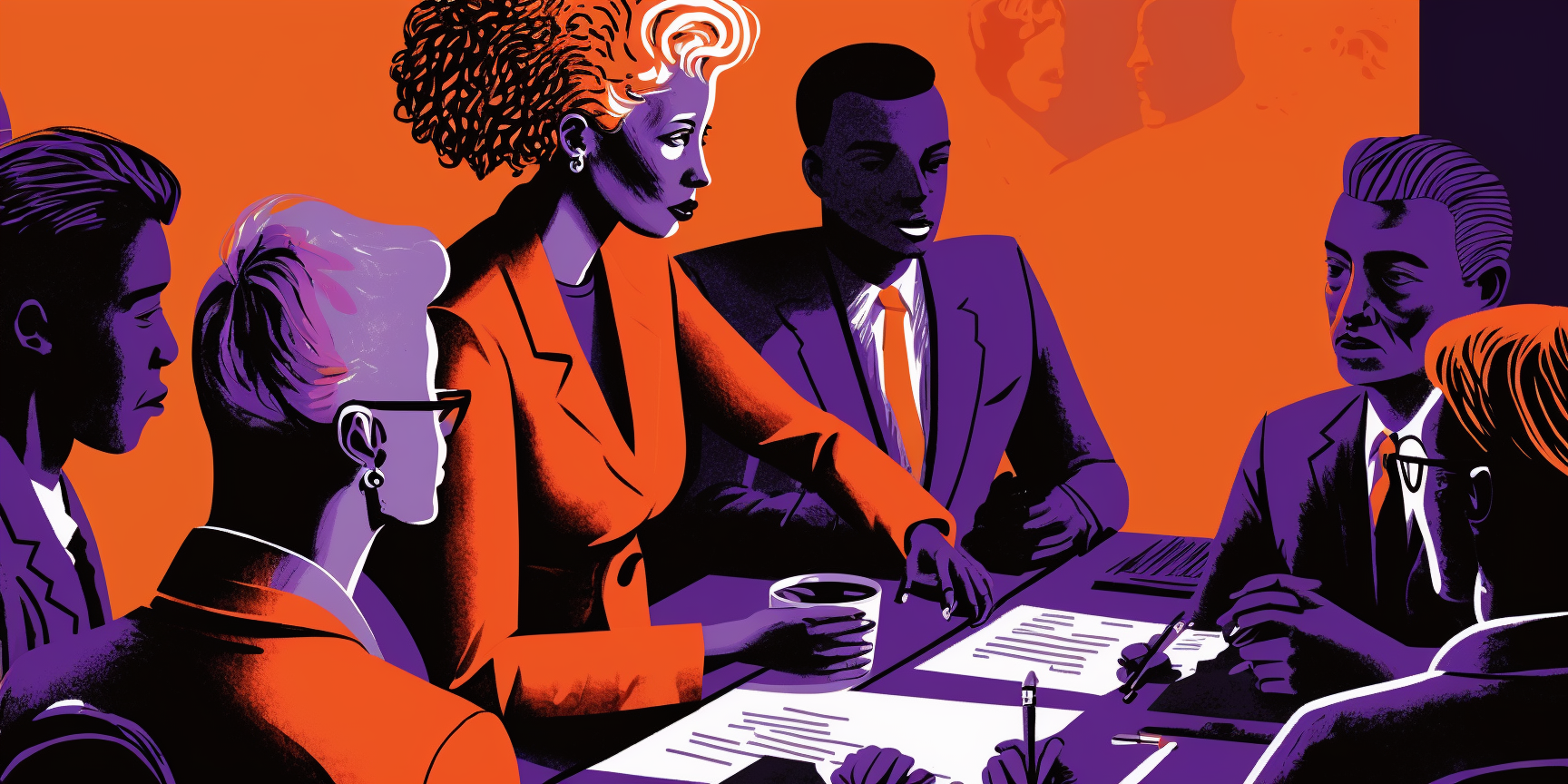Table of Contents
Introduction
Welcome to Business Technology 101! In today's article, we'll be looking at marketing automation. If you missed my earlier articles in the series where we explored customer relationship management, you can find them here:
Want to be the master of your marketing teams? Want to run ridiculously effective marketing campaigns? Want to reap extra rewards from your marketing and sales efforts? Me too!
Thumbs up, let's do this!

What is marketing automation?
Marketing automation is using software and technology to automate marketing processes and tasks, allowing businesses to streamline their marketing efforts and optimize their results.
By automating time-consuming and repetitive tasks such as lead nurturing, email marketing, and social media management, marketing automation allows businesses to focus on more strategic and creative aspects of marketing.
Importance of marketing automation
In today's business landscape, where customer expectations are high, and competition is fierce, marketing automation software has become an essential tool for businesses of all sizes and industries.
With its ability to improve lead generation and conversion rates, increase efficiency and productivity, and enhance the customer journey, marketing automation has become a critical component of modern marketing strategies.
So, what are we doing today?
We will explore the benefits of marketing automation, how it works, and how businesses can set up a successful marketing automation solution. We will also discuss best practices for implementing marketing automation and everyday challenges. Finally, we will look at the future of marketing automation and the trends and developments that are shaping its evolution.
Benefits of marketing automation

Marketing automation offers numerous benefits to businesses looking to optimize their marketing efforts.
Improved lead generation and conversion rates
Marketing automation allows businesses to nurture leads through the buying process, delivering the right message at the right time to move them closer to making a purchase. By tracking and analyzing customer behavior and engagement, marketing software can help identify the most promising leads and provide personalized messaging to convert them into customers.
Increased efficiency and productivity
By automating repetitive tasks such as email marketing, social media marketing, and lead nurturing, marketing automation frees up marketers' time to focus on more strategic and creative aspects of marketing. This can lead to increased productivity and a more streamlined marketing process.
Enhanced customer experience
Marketing automation enables businesses to provide personalized messaging and content to customers based on their interests and behavior. This can improve the customer experience, increase engagement, and ultimately lead to higher customer satisfaction and loyalty.
Data-driven decision making
Marketing automation tools provide valuable insights into customer behavior and engagement, allowing businesses to make data-driven decisions about their marketing strategy. By tracking and analyzing key metrics such as open rates, click-through rates, and conversion rates, businesses can optimize their marketing efforts for maximum effectiveness.
How does marketing automation work?

Overview of the marketing automation process
Marketing automation automates repetitive tasks and processes, allowing businesses to deliver the right message to the right customer at the right time. A marketing team would implement a strategy like this:
Identify and attract potential customers: This involves creating and promoting content that appeals to your target audience and drives traffic to your website or landing pages.
Capture leads: Once visitors are on your website or landing pages, you'll want to capture their contact information through forms, landing pages, or other lead capture methods.
Nurture leads: This involves delivering targeted messaging and content to leads based on their behavior and engagement, moving them through the buying process, and ultimately converting them into customers.
Close sales: Once leads are ready to purchase, you'll want to provide them with a seamless buying experience and ensure the transaction is completed smoothly.
Analyze and optimize: By tracking and analyzing key metrics such as open rates, click-through rates, and conversion rates, perhaps with a little A/B testing, you can identify areas for improvement and optimize your marketing efforts for maximum effectiveness.
Marketing automation software and platforms can help businesses automate many tasks and processes, allowing for more efficient and effective marketing campaigns. Some common marketing automation tools and platforms include HubSpot, Marketo, and Pardot.
Some of the best marketing automation software available today

HubSpot: HubSpot is a popular marketing automation platform that offers a wide range of tools and features for businesses of all sizes. Its features include email marketing, lead nurturing, social media management, landing pages, analytics, and more.
Marketo: Marketo is a comprehensive marketing automation platform that offers features such as lead scoring, lead nurturing, email marketing, social media management, and analytics. It's designed to help businesses optimize their marketing efforts and improve ROI.
Pardot: Pardot is a marketing automation platform designed explicitly for B2B marketers. It offers lead scoring, lead nurturing, email marketing, analytics, and more features.
ActiveCampaign: ActiveCampaign is a marketing automation platform known for its user-friendly interface and powerful automation capabilities. Its features include email marketing, CRM, automation workflows, and more.
Mailchimp: Mailchimp is a popular email marketing platform offering marketing automation features. Its automation workflows allow businesses to send targeted messages and content to customers and prospects based on their behavior and engagement.
Example of marketing automation workflows

Marketing automation workflows are typically created using a combination of triggers, actions, and conditions.
- A visitor lands on your website and fills out a contact form to download a white paper.
- The contact information is automatically added to your CRM, and a lead score is assigned based on the information provided.
- An automated email is sent to the lead thanking them for downloading the white paper and providing them with a link to access it.
- Based on the lead score, the lead is placed into a specific nurture campaign, receiving targeted emails over several weeks.
- If the lead engages with the emails and shows interest, their lead score increases and the lead is passed to a salesperson for follow-up.
- If the lead does not engage with the emails, they are placed into a re-engagement campaign, where they receive a series of targeted emails to encourage them to re-engage with your brand.
- Once the lead becomes a customer, they are placed into a post-purchase nurture campaign, receiving targeted emails based on their purchase history and behavior.
- Based on their engagement with the post-purchase nurture campaign, they may be added to an upsell or cross-sell campaign, receiving targeted offers based on their purchase history and behavior.
Setting up a marketing automation strategy

Identifying business goals and objectives
Before implementing marketing automation, businesses need to identify their goals and objectives. By setting clear goals, companies can ensure that their efforts align with their overall strategy and drive meaningful results.
Define your target audience:
Businesses must first understand their target audience to set effective goals and objectives. This includes identifying key demographics, interests, pain points, and buying behaviors.
Determine your marketing funnel:
Next, businesses should map out their marketing funnel and identify critical stages such as awareness, consideration, and conversion. This will help them understand where marketing automation can have the most significant impact.
Set specific goals and objectives:
Set specific goals and objectives for your marketing automation efforts based on your target audience and marketing funnel. For example, you might aim to increase lead generation by 20%, improve conversion rates by 10%, or reduce the time and resources spent on manual marketing tasks.
Align goals and objectives with overall strategy:
Ensure your marketing automation goals and objectives align with your overall business strategy and objectives. This will help ensure your efforts drive meaningful results and contribute to your bottom line.
Track and analyze key metrics:
Once your marketing automation efforts are underway, track and analyze key metrics such as open rates, click-through rates, conversion rates, and ROI. This will help you optimize your marketing automation workflows for maximum effectiveness.
Understanding the target audience and buyer personas

In addition to setting clear goals and objectives, understanding your target audience is crucial to effective marketing automation. By developing buyer personas and understanding their needs, preferences, and behavior, businesses can create more personalized and targeted messaging that resonates with their audience. Want to know how to understand your target audience? Start here!
Gather demographic and psychographic data:
Collect data on your target audience's demographics, such as age, gender, income, and location, and psychographic data, such as interests, values, and behaviors. This can be done through surveys, interviews, and other forms of research.
Identify pain points and challenges:
Understand the challenges and pain points that your target audience faces. This will help you create messaging and content that addresses their needs and solves their problems.
Develop buyer personas:
Based on your collected data, develop buyer personas representing your target audience segments. A buyer persona is a fictional character that represents a specific segment of your audience and includes information such as demographics, goals, challenges, and preferences. Many marketing teams give their buyer personas alliterative and descriptive names like Cheap Charles or Realistic Robert.
Tailor messaging and content:
Use your buyer personas to tailor your messaging and content to each audience segment's specific needs and preferences. This will help you create more personalized, targeted messaging that resonates with your audience.
Continuously update and refine personas:
As your business evolves and your target audience changes, it's important to continuously update and refine your buyer personas to ensure that your messaging remains relevant and effective.
Creating a content marketing plan

Creating a content marketing plan is another crucial step in implementing effective marketing automation. By developing a strategy for creating and distributing content, businesses can attract and engage their target audience, drive leads and conversions, and build brand awareness. But wait! How do I create a content marketing plan? Read on, dear friend!
Define your content goals and objectives: Start by defining your content goals and objectives. What do you want your content to achieve? Do you want to generate leads, build brand awareness, drive conversions, or do all of the above?
Understand your audience: Use your buyer personas to understand your target audience's needs, preferences, and behavior. This will help you create relevant content that resonates with them and provides value.
Develop a content strategy: Based on your goals and audience insights, develop a content strategy that outlines the types of content you'll create, the channels you'll use to distribute it, and the frequency of your content production.
Create high-quality content: Develop high-quality content that's engaging, informative, and valuable to your audience. This could include blog posts, videos, infographics, white papers, etc.
Distribute and promote your content: Use automation to distribute and promote your content to your target audience. This could include email marketing automation, social media, and other tactics that help you reach your audience where they are.
Measure and optimize your results: Continuously measure and optimize your content marketing campaign by tracking key metrics like website traffic, engagement, and conversion rates. This will help you identify areas for improvement and refine your content strategy over time.
Developing lead nurturing campaigns
Developing lead nurturing campaigns is another essential aspect of effective marketing automation. Lead nurturing campaigns involve automated messages designed to build relationships with leads and move them closer to making a purchase.
Identify your leads: Start by identifying your leads and segmenting them based on factors such as their behavior, interests, and demographics.
Define your campaign goals: Next, define the goals of your lead nurturing campaign. Do you want to move leads through the sales funnel, increase engagement, or drive conversions?
Develop your campaign content: Based on your campaign goals and your target audience's needs and preferences, develop a series of messages that provide value and build relationships with your leads. These could include emails, social media posts, and other types of content.
Set up your automation workflows: Use marketing automation tools to create lead-nurturing workflows. These workflows should trigger messages based on specific actions or behaviors, such as opening an email or visiting a specific webpage.
Monitor and optimize your campaigns: Continuously monitor and optimize your lead nurturing campaigns by tracking key metrics such as open rates, click-through rates, and conversion rates. Use this data to refine your messaging and optimize your workflows over time.
Best practices for implementing marketing automation

Creating a well-defined lead-scoring system
A well-defined lead scoring system is a critical component of successful marketing automation. Lead scoring assigns a numerical value to each lead based on their behavior and interactions with your brand. This helps you prioritize leads and determine which ones will most likely become customers.
How do I go about creating a well-defined lead-scoring system? I'm glad you asked!
Define your ideal customer profile: Start by defining the characteristics of your ideal customer. This should include job title, company size, industry, and geographic location. Use this information to create a buyer persona of your ideal customer.
Identify critical behaviors: Identify the key behaviors that indicate a lead is interested in your product or service. This might include visiting your website, downloading a white paper, attending a webinar, or requesting a demo.
Assign point values: Assign point values to each behavior based on its importance and relevance to your sales process. For example, a lead requesting a demo might be assigned more points than a lead downloading a white paper.
Set thresholds: Set threshold scores that indicate when a lead is ready to be passed to sales. For example, a lead with a score of 50 might be considered a Marketing Qualified Lead (MQL), while a lead with a score of 80 might be regarded as a Sales Qualified Lead (SQL).
Refine and iterate: Continuously monitor and refine your lead scoring system based on feedback from your sales team and performance data. This will help you ensure that you target the right leads and deliver the right messages at the right time.
Personalizing messaging and content
Personalizing messaging and content is a crucial component of effective marketing automation. Personalization involves tailoring your messages and content to individual leads and customers' specific needs and preferences. This helps you build stronger relationships with your audience, increase engagement, and drive more conversions.
Collect data: Collect as much data as possible on your leads and customers, including demographic information, behavior, and preferences. This might include data from your CRM system, email marketing platform, social media, or website analytics. If Google and Facebook can collect all the data, why can't you? It will help your efforts.
Segment your audience: Use this data to segment your audience into groups based on behavior, interests, and demographics. This will allow you to deliver more targeted and relevant messages.
Develop buyer personas: Develop detailed buyer personas that capture each segment's needs, preferences, and behaviors. Use these personas to inform your messaging and content strategy. I've said this a couple of times. Do this part!
Create personalized content: Develop personalized content that speaks directly to the needs and interests of each segment. This might include personalized emails, landing pages, product recommendations, or social media messages. Content is king!
Automate your campaigns: Use marketing automation tools to automate your campaigns and deliver personalized messages at the right time and through the proper channels.
Continuously test and optimize: Continuously test and optimize your messaging and content based on performance data. Use A/B testing and other techniques to refine your messages and improve engagement rates. Get in the weeds and analyze everything you can.
By personalizing messaging and content, businesses can build stronger relationships with their audience and increase the effectiveness of their marketing automation campaigns. This ultimately leads to increased conversions and revenue growth.
Segmenting email lists

Segmenting email lists is a critical strategy for effective marketing automation. Email list segmentation involves dividing your email list into smaller groups based on specific characteristics or behaviors. This allows you to send more targeted and relevant messages to each segment, which can increase engagement and conversion rates.
Define your segments: Start by defining the different segments of your email list based on factors such as demographics, behavior, interests, and preferences. You might segment your list based on location, purchase history, or engagement level.
Gather data: Collect data on your subscribers, including information from your CRM system, website analytics, and email marketing platform. This will allow you to create more detailed and accurate segments.
Create targeted messages: Develop targeted messages for each segment that speak directly to their needs and interests. This might include personalized content, product recommendations, or special offers.
Automate your campaigns: Use marketing automation tools to automate your email campaigns and deliver targeted messages at the right time and through the proper channels.
Monitor performance: Continuously monitor the performance of your email campaigns to determine which segments are most engaged and which messages are most effective. Use this information to refine your segments and messaging strategy over time.
By segmenting your email list, you can deliver more targeted and relevant messages to your subscribers, increasing engagement and conversion rates. This ultimately leads to a more effective email marketing program and increased revenue growth for your business.
Common challenges and how to overcome them

While marketing automation can be a powerful tool for driving growth and revenue, there are also several common challenges that businesses may face when implementing marketing automation:
Lack of resources: Marketing automation requires significant time and resources to set up and manage effectively. Businesses may struggle to allocate the necessary resources, such as personnel, budget, and technology, to implement and maintain their marketing automation programs.
Poor data quality: Marketing automation relies on accurate and up-to-date data. Poor data quality, such as incomplete or outdated customer records, can lead to ineffective campaigns, inaccurate segmentation, and poor engagement rates.
Lack of integration: Marketing automation tools often require integration with other systems, such as CRM, social media, and analytics platforms, to be effective. If these integrations are missing or not correctly set up, businesses may struggle to leverage their marketing automation tools' power fully.
Ineffective targeting: Marketing automation requires accurate targeting to be effective. If businesses do not segment their audience properly, develop targeted messaging, or properly set up lead scoring, they may struggle to engage with their audience effectively.
Lack of personalization: As we discussed earlier, personalization is vital to effective marketing automation. Businesses that fail to personalize their messages and content may struggle to engage with their audience and drive conversions effectively.
Over-reliance on automation: While automation is a critical component of marketing automation, businesses should also focus on building personal customer relationships. Over-reliance on automation can lead to a lack of personalization and human connection, which can be detrimental to engagement and loyalty.
By understanding these common challenges, businesses can take steps to overcome them and build more effective marketing automation programs. This might include investing in data quality initiatives, improving targeting and personalization, and building strong customer relationships through automation and personal touchpoints.
Future of marketing automation

The future of marketing automation is exciting, as technological advancements and changing consumer behaviors continue to drive innovation and growth in the industry. Here are some key trends and predictions for the future of marketing automation:
Artificial intelligence (AI) and machine learning (ML) are already playing a significant role in marketing automation, and this trend is only set to continue. These technologies can help businesses analyze vast amounts of data, automate tasks, and deliver more personalized experiences to customers.
As voice search becomes more prevalent, businesses must adapt their marketing automation strategies to incorporate this technology. Conversational marketing, which leverages chatbots and other AI-powered tools to engage with customers in real time, is also set to become more popular.
As consumers demand more personalized experiences, businesses must continue refining their targeting and personalization strategies. Hyper-personalization, which leverages AI and other technologies to deliver highly tailored content and messages to each customer, is set to become more prevalent.
Marketing automation will evolve to include more channels and touchpoints as consumers increasingly engage with brands across multiple devices and platforms. Cross-channel integration will be critical for delivering consistent and personalized experiences across all touchpoints.
As data breaches and privacy concerns continue to make headlines, businesses will need to focus on ensuring the security and privacy of customer data. Marketing automation platforms must prioritize data privacy and security and ensure compliance with regulations such as GDPR and CCPA.
The future of marketing automation is promising as businesses continue to leverage technology to deliver more personalized, targeted, and engaging experiences to their customers. Businesses that stay on top of the latest trends and technologies will be best positioned to succeed.
Conclusion
Marketing automation is a powerful tool that can help businesses streamline their marketing efforts, improve their ROI, and deliver more personalized customer experiences. Companies can drive more leads, convert prospects, and build stronger customer relationships by automating repetitive tasks, segmenting audiences, and leveraging data to inform their strategies.
While marketing automation can be complex, the benefits are worth the effort. By following best practices and working with the right tools and platforms, businesses can create highly effective marketing automation campaigns that deliver results.
Are you looking to up your marketing game? Would you like a set of outside eyes to help you audit the automation solutions you already have in place? Just go ahead and smash that like button; wait, wrong platform, but we'd love to hear from you if your company needs some help with its automation efforts. Stay tuned for more Business Technology 101!
Related Resources

What To Do If Your Minimum Viable Test Gets No Signups from Paid Traffic: A Decision Framework
Launching a startup or new product is risky, and smart founders reduce that risk by validating demand early. One proven method is the minimum viable...

How to Keep an AI Assistant Focused and Structured in Long-Term Projects
Artificial Intelligence (AI) assistants, like ChatGPT, can be tremendously helpful in managing complex projects—serving as brainstorming partners,...
.png?width=200&height=86&name=RBP_Logo-Design_02%20(1).png)

.jpg)